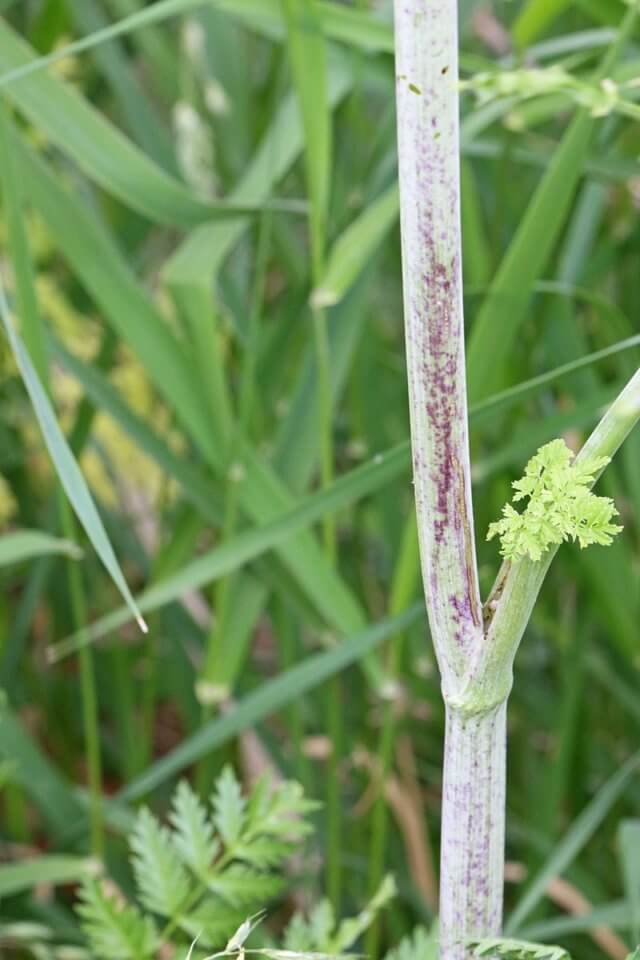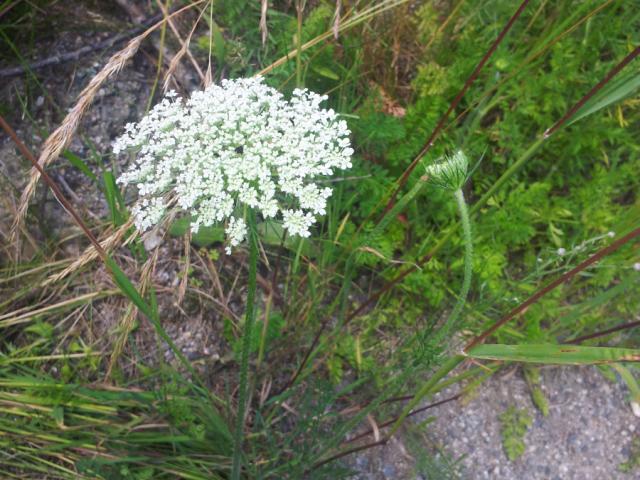Part One: Poison Hemlock (Conium maculatum)
Often when we talk about invasive plants you hear about the potential they have to cause significant economic or ecological damage, but what about impacts to our health? In this series we will explore three hazardous plants to be aware of to keep you, your family and friends out of harms way.
Poison Hemlock Identification
- A biennial in the carrot family often found in sunny areas, open fields, vacant property and roadsides.

How can you ID poison hemlock? Look at the stem and if it has reddish or purple streaking/spotting, the stalk is NOT hairy and hollow chances are it’s poison hemlock. - Bright green, fern-like leaves, finely divided with strong musty smell when crushed.
- Stems have reddish or purple streaking/spotting, are NOT hairy and hollow.
- Numerous small, umbrella-shaped clusters of tiny white flowers found on ends of branched stems.
- In the first year plants are low growing and can mistaken for carrots.
- Second year plants can reach between 6-8 feet tall with a number of umbrella-shaped flowers.
Look A Likes
- Mature poison hemlock can be confused with another invasive plant, Queen Anne’s lace (Daucus carota). How can you tell the difference? Queen’s Anne lace has narrow hairy stems, grows to only 3 feet tall and flowers later in the summer months.

Queen Anne’s lace
(Daucus carota)Consequences of Invasion
- WARNING! All parts of the plant are DEADLY to people, livestock, and wildlife when ingested.
- The dead canes remain toxic for up to three years!
- Toxic to the skin and respiratory system.
- Symptoms for humans include dilation of the pupils, dizziness, and trembling, slowing of the heartbeat, paralysis of the central nervous system, muscle paralysis, and death due to respiratory failure. For animals, symptoms include nervous trembling, salivation, lack of coordination, pupil dilation, rapid weak pulse, respiratory paralysis, coma, and sometimes death. For both people and animals, quick treatment can reverse the harm. If you suspect poisoning from this plant, call for help immediately. Call 911 or Poison Control Centre 1-800-567-8911.

How to control?
- Mechanical: For small patches, roots may be dug up. Wear protective equipment and wash hands thoroughly after treatment.
- NEVER mow poison hemlock, mowing can disperse inhalable toxins into the air.
- Chemical: Herbicides are available.
- Consult a certified pesticide applicator for chemical control options. More information here.
- Biological: None to date.
- Adding layer of mulch or replanting will reduce germination of seeds.
- DO NOT COMPOST, bag plant materials and bring to landfill.
- All landfills within the RDCK and RDKB accept invasive plant species for free. Ensure your material is bagged in clear plastic bags and notify the attendant that you have hazardous invasive plant species. Plants must be identifiable through the bag. For more information please see the RDCK Resource Recovery Bylaw.

All landfills within the RDCK and RDKB accept invasive plant species for free. Ensure your material is bagged in clear plastic bags and notify the attendant that you have invasive plant species. Plants must be identifiable through the bag.
More Information Available
- BC Weed Guide
- King County Noxious Weed Alert
- Hazardous Plants in the Kootenay Region: Wild Parsnip
- Hazardous Plants in the Kootenay Region: Giant Hogweed



